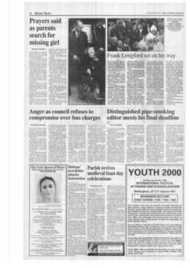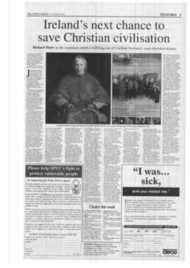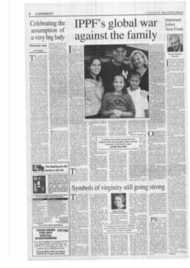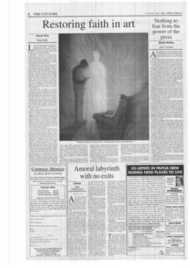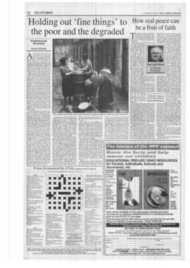Page 8, 17th August 2001
Page 8

Report an error
Noticed an error on this page?If you've noticed an error in this article please click here to report it.
Tags
Share
Related articles
Phew! Thank God For A Dose Of Beautiful Art
Child's Play In Ny
Art That Shocks And Eviscerates
Inside The Saatchi Studio
Why This Self Indulgence Should Not Get The Turner Prize
Restoring faith in art
Visual Arts Greg Watts
Last year, Charles Saatchi coughed up a reported £150,000 for "The Bed" by controversial artist Tracy Emin. There's a joke that as his cleaner was leaving his house one morning, she called to him. Oh, by the way, I've made up the bed.
"The Bed", which was a finalist for the Turner Prize, consisted of an unmade bed, surrounded by items such as condoms, underwear and soiled sheets. This piece of art was par for the course for Emin, who first shot to fame with an exhibition built around 100 men she had slept with between 1963 and 1995.
But Emin is just one of many British artists who claim to be pushing back the frontiers of art through sensationalist exhibitions such as these. Damien Hirst has presented us with a pickled sheep, Chris Ofili with elephant dung. Recently, my father, an artist, visited modern art's new cathedral, the Tate Modern. When I asked him what it was like, he replied: "Well, there was hardly anything there; just empty space." This didn't surprise me. Instead, it confirmed my suspicions that the art establishment is engaged in disseminating a new version of the Emperor's New Clothes. The galleries have convinced us that if we don't understand a piece of work, then it's our problem, not theirs.
Pope John Paul, in a letter to the world's artists at Easter 1999, spoke of how art could act as a bridge to religious experience, even where the Church and culture were far apart. Art must make perceptible, and as far as possible attractive, the world of the spirit, of the invisible God, he wrote. So, what of art as a tool for building a bridge between man and God? How is it that artists such as Giotto, Michelangelo and Raphael sought to capture aspects of the divine, while today in Britain, and other Western countries, the message of art seems to be that God is dead?
There are signs that there may be a growing revival of art that celebrates the divine spark in each of us. Tellingly, the most popular art exhibition in the UK last year was not one that lauded Tracy Emin or Damien Hirst but one that celebrated how artists down the centuries tried to convey Christ. Seeing Salvation, at London's National Gallery. confounded the art establishment, which seemed to think the only way tp gain publicity and keep the tills ringing was to promote the sensational and lurid. And the world's most popular art exhibition last year was a religious one in Milan.
Away from the hype and champagne of the art establishment, there are artists who are quietly attempting to build bridges between man and God. One of the more unusual is Elizabeth Wang, who will host an exhibition in the conference room at St Paul's bookshop. next to Westminster Cathedral, from August 23 to September 1. Originally a botanical painter, who had exhibited at a number of leading galleries, including the Royal Academy, Elizabeth switched to painted about prayer when she found it difficult to continue highly detailed work, due to a mild, long standing multiple sclerosis, which was finally diagnosed in 1989.
Today, her main subject is the Mass and how it unites earth with Heaven. She also believes her work is part of a mission given to her by Christ and claims to have received a number of private revelations since1985. Rightly, many Catholics are cautious about accepting claims of private revelation. But Elizabeth's paintings do seem to portray some powerful, imaginative and thought provoking theological insights. For example, "Christ is Our Bridge" depicts a mass of humanity making their way across Christ's outstretched arms. which provide a bridge between the darkness of earth and the light of Heaven. "In Sickness and in Frailty" shows a woman about to receive communion at home from a Eucharistic minister. Standing alongside the minister is a radiant image of Christ.
Elizabeth is not the only Catholic artist seeking to bridge the gap between religious faith and art. For example, David Clayton has turned to painting icons, traditionally the domain of Orthodox artists. Award-winning portrait painter Christian Furr, for whom the Queen sat, is currently working on a portrait of Cardinal Murphy-O'Connor. To the question: what is art? there is, of course, no easy answer. But, perhaps, durability is a good litmus test. Will the work of artists such as Tracy Emin survive into the next millennium?
I think we all know the answer to that one. But there is another point to be made. With a few exceptions, the Church has withdrawn its patronage from artists and seems to make little contribution to cultural life. Much of the contemporary art we see in our churches is as bland and saccharine as it is lamentable. The time has surely come for the Church to reclaim art and use it to confront man with his divine origin and destiny.
Elizabeth Wang is one of 20 people included in Greg Watts' book Catholic Lives: Contemporary Spiritual Journeys, which will be published by Gracewing on September 13.
blog comments powered by Disqus





